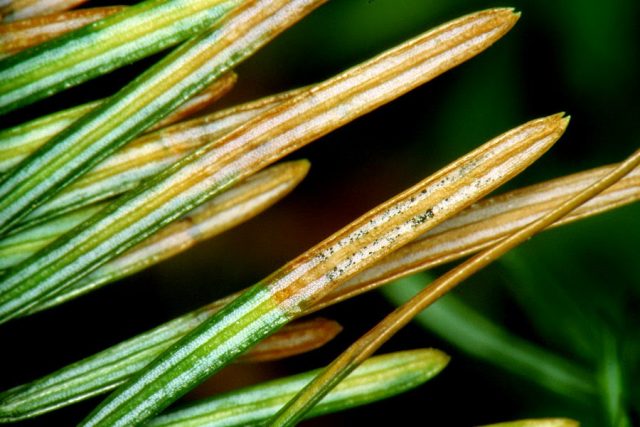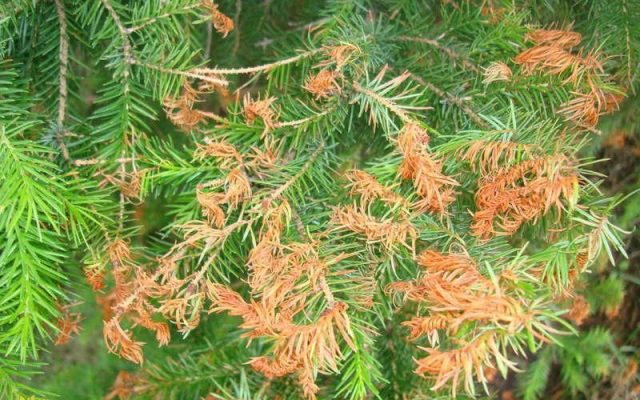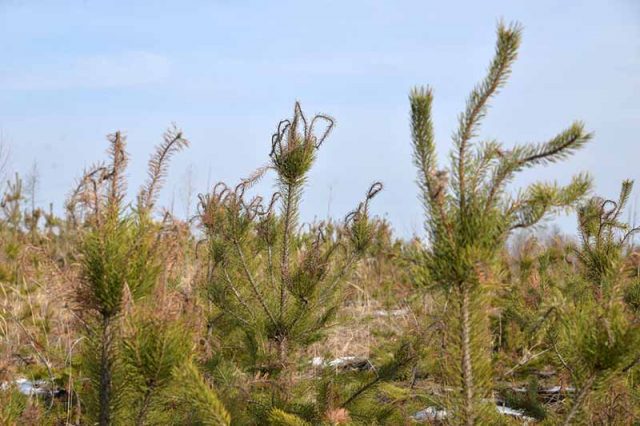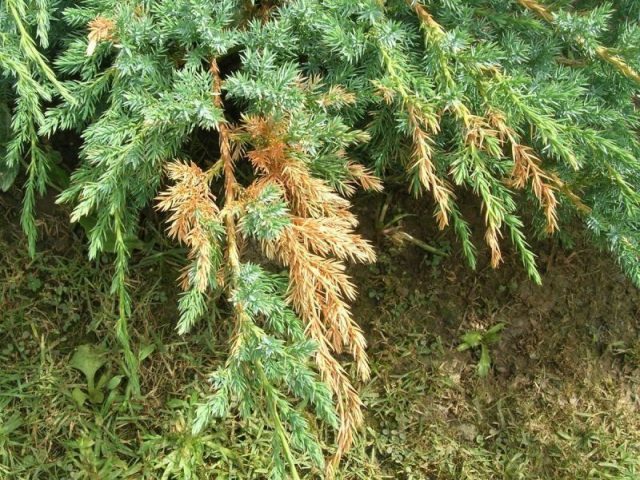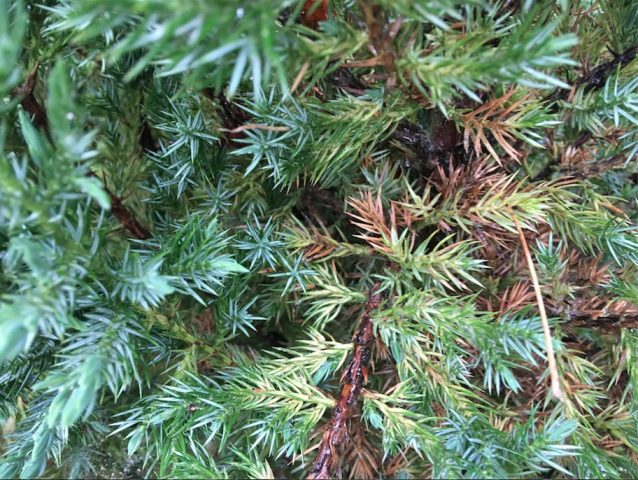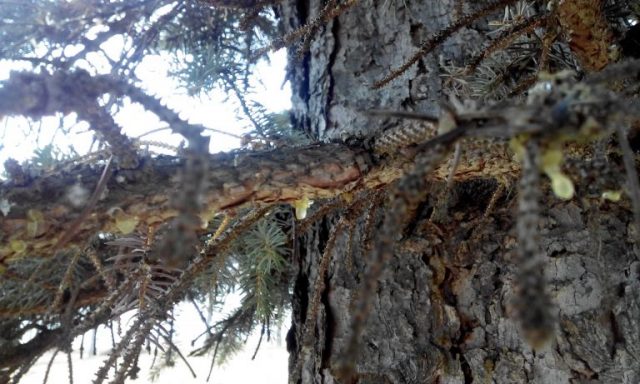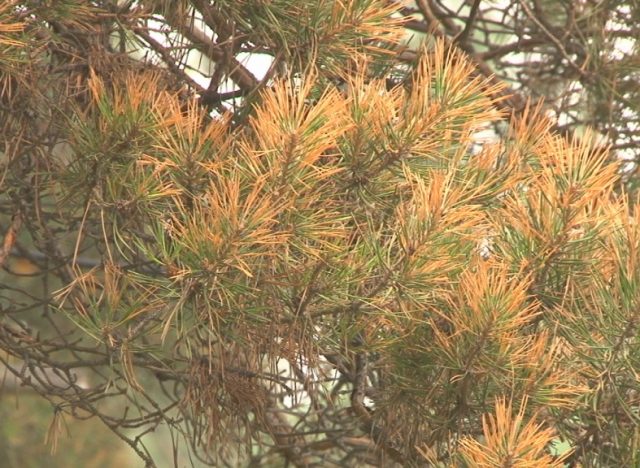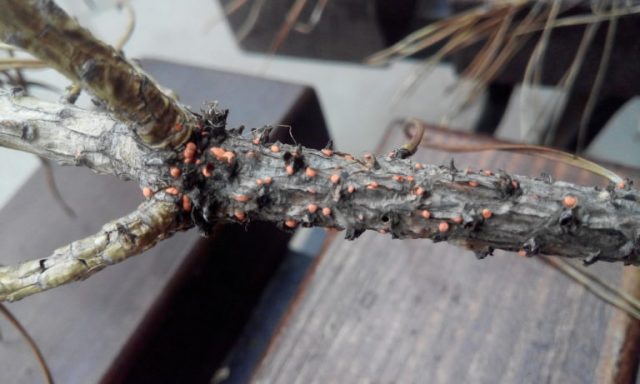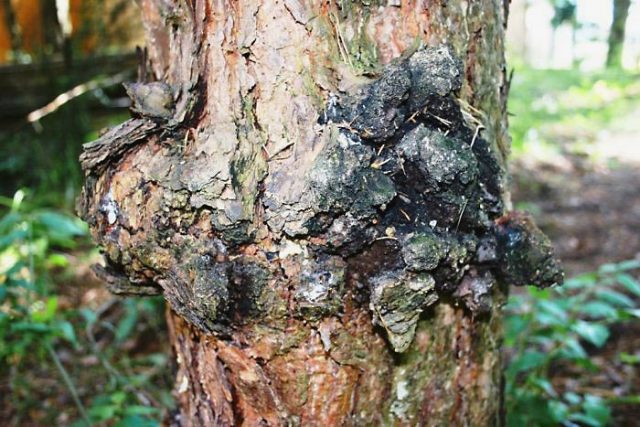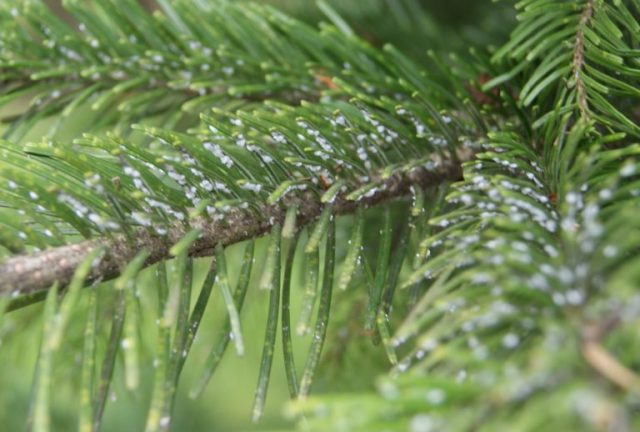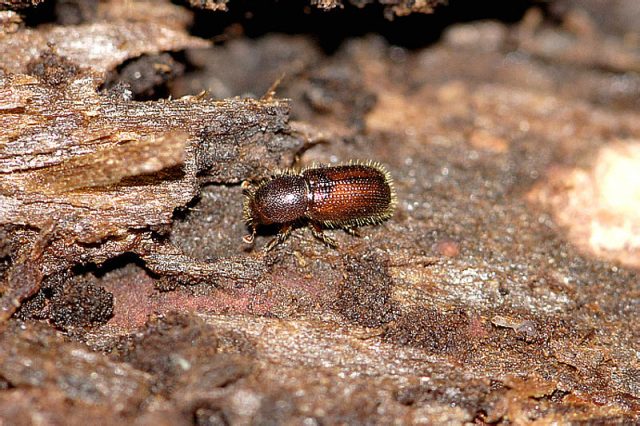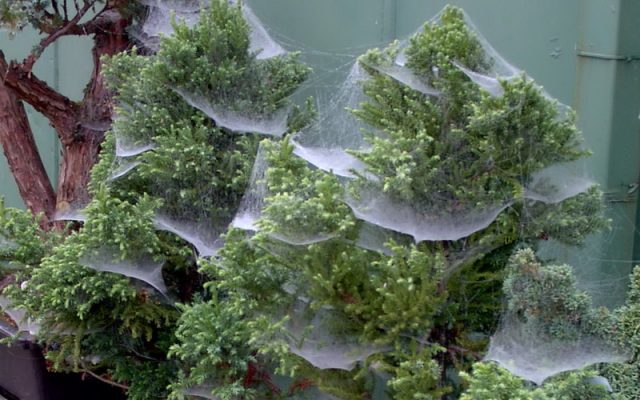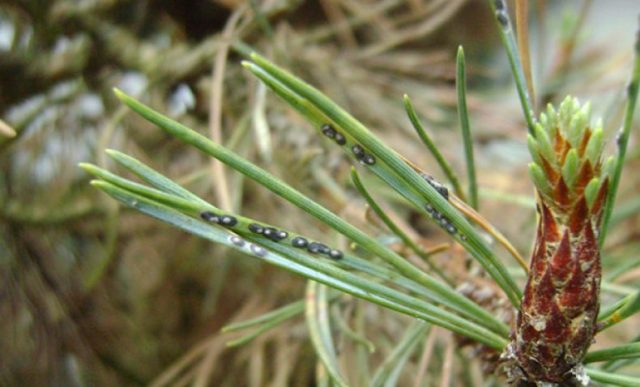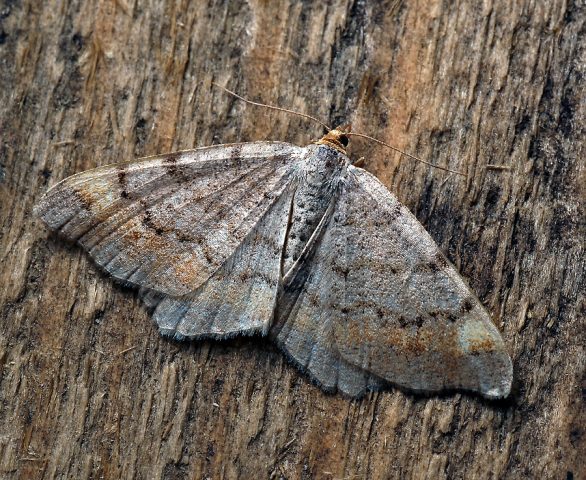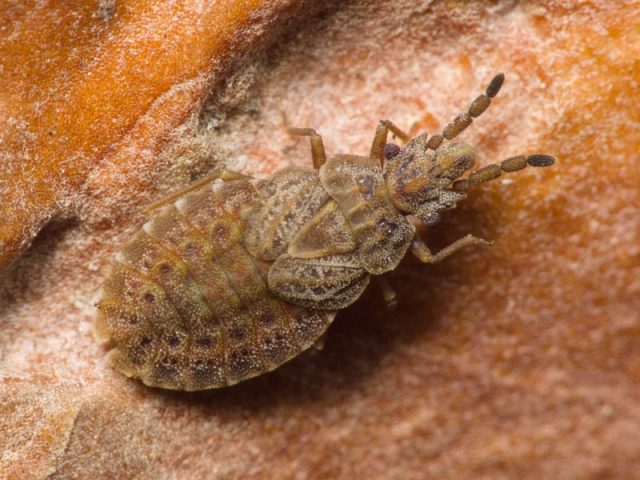Content
Coniferous diseases are very diverse and can affect evergreens even with good care. In order to prevent the death of plantings, you need to know the main symptoms of wood ailments and methods of treatment.
Ephedra diseases and their treatment
Basically, coniferous diseases are of fungal origin and are very dangerous for plants. Symptoms of some ailments can be noticed immediately, others appear only after a while. In order not to miss the alarming signals, the gardener needs to know the photo and description of the diseases of conifers.
Schütte
The disease called shute exists in several varieties, it is customary to distinguish real, snow and brown shute. The disease affects pines and spruces, junipers and firs, as well as other conifers. A harmful fungus that provokes the appearance of any shute develops under the snow at temperatures above 0 ° C, and the symptoms of the disease appear in spring or summer, after the snow melts.
The signs of shute are gray-black plaque on the needles and microscopic black dots on individual needles. Snowy, real and brown shute is especially dangerous for young pines, spruces, junipers and other conifers. As the disease progresses, the needles of conifers begin to turn yellow and brown, and then fall off.
To treat the disease, it is necessary to treat the plantings with Bordeaux liquid throughout the warm period, as well as fungicidal solutions, such as sulfur-lime broth, Abiga-Peak, HOM. Sanitary pruning of the affected branches and soil cultivation are also necessary, the root zone needs compulsory treatment, since the spores of the shute fungus develop precisely in the soil at the roots of conifers.
Rust
Fungal disease rust mainly affects pines and larch trees in summer cottages. The disease is characterized by the spring appearance of yellow-orange spots on wood needles, which eventually acquire a brown color and begin to crumble.
In the early stages, rust disease is treatable with fungicides and Bordeaux mixture. It is better to remove and burn heavily affected shoots of the plant. Healthy and slightly affected branches of a coniferous tree should be sprayed with medicinal solutions throughout the season - 3 times with an interval of 15-20 days.
Pine wither
As the name implies, fungal disease mainly affects pine trees. Its action is manifested in the fact that the lateral shoots of the plant are strongly curved, and the apical shoot dies off. At the same time, on the needles, yellow-orange swellings located in chains appear. The development of the disease leads to the fact that the growth of the coniferous tree stops, and after a while the pine tree may die.
Treatment of the disease in the early stages is carried out with Bordeaux liquid or Fundazole, spraying is carried out twice a season. Particular attention should be paid to the processing of young trees; pines that have not reached 10 years of age are often affected by the vertun.
Fusarium
Disease of conifers Fusarium and root rot is caused by pathogenic fungal flora that develops in the soil at the roots. Fusarium is dangerous not only for spruces and pines, but also for larches and firs. Outwardly, the disease manifests itself in the fact that the needles of trees acquire a red tint and crumble, and mainly the middle part of the crown is affected.Root decay often occurs in young trees.
Treatment of the disease consists primarily in the treatment of conifers with fungicidal preparations - Bordeaux liquid, phytosporin, alirin. It is also necessary to control the quality of the soil in the area with conifers; Fusarium most often develops on waterlogged soil with poor drainage.
Alternaria
Alternaria fungus develops mainly on the trunks and needles of junipers and thuja. You can recognize it by blackish or dark gray spots on the shoots, these spots are colonies of the fungus and gradually spread along the needles, leading to the death of the plant. The disease appears most often on conifers forced to develop in insufficient lighting.
Thus, the best prevention of Alternaria disease is a careful choice of a place for planting thuja or juniper. Sick conifers need to be treated with Bordeaux liquid, quickly and purely, spraying begins in early spring and is carried out monthly throughout the summer. Shoots of conifers affected by the disease must be removed, and the sections are treated with copper sulfate to prevent further spread of the fungus.
Bacteoriasis
A great danger for conifers is a bacterial infection of vascular bacteriosis. An unpleasant feature of the disease is that the needles do not change their color and are not covered with spots, but simply dimmer, therefore, the disease is often not immediately noticed. But, nevertheless, as the disease develops, the needles begin to crumble abundantly from the branches from the slightest touch.
In order not to miss the symptoms of bacteriosis, it is recommended to examine trees more often for disease damage. At the first symptoms, the soil is treated with Fundazol, after another 3 days - with Fitosporin, and a few days after that - with Zircon. As a rule, the use of antiseptic drugs can save diseased conifers from death.
Biotorella cancer
The disease of fungal origin does not affect the needles, but the wood of evergreens. When infected with biotorella cancer, the bark of conifers first turns brown, then becomes covered with cracks and begins to dry out and die off. In place of the dead areas of the bark, long elongated ulcers form, and then resinous fungal growths appear in their place. As the fungus develops, the needles turn yellow and crumble.
In order to notice the disease in time, you need to regularly inspect the trunk and shoots of the plant. At the first symptoms of biotorella cancer, treatment with Bordeaux liquid and proven fungicides is required, it is advisable to repeat it 2-3 times per season.
Nectric cancer
Another disease of conifers manifests itself in the form of numerous microscopic growths of a red-orange color that appear on the surface of the trunk. Gradually, the growths become darker and dry out, the bark begins to die off, and the needles turn yellow and fall off.
Treatment of the disease is carried out with the help of preparations containing copper, the soil at the roots of conifers must be carefully shed with fungicides. Since the spread of fungal spores comes from the roots, it is necessary to carefully monitor the cleanliness of the near-stem circle and remove branch trimmings, fallen needles and other debris in time.
Gray rot
A disease called gray rot, or mold, is characterized by the appearance of an ash-gray cobweb plaque on the needles. During its development, the fungus grows into the roots of conifers and quickly leads to tissue death and death. Especially gray rot is dangerous for young conifers that did not have time to get stronger after planting in the ground. Most often, the disease affects conifers growing on waterlogged soil with a lack of sunlight.
For the treatment of gray rot, it is necessary to remove all the affected parts of the ephedra, and then treat the trunks and needles with Bordeaux liquid and Ferbam's solution - twice with an interval of 12 days.To prevent disease, it is necessary to monitor the level of soil moisture and timely feed the conifers with potassium and phosphorus.
Shrinking branches
The disease mainly affects junipers, thuja and young pines, and symptoms are manifested by the drying of the bark on the tree trunk and the appearance of brown and black growths on it. The needles of plants acquire a yellow tint and crumble, the shoots begin to dry and bend.
Treatment of the disease is carried out by spraying the conifers with fungicidal preparations and Bordeaux liquid. Since most often the drying of branches develops on conifers that grow too densely and do not receive enough sunlight, if necessary, the plants can be transplanted away from each other.
Necrosis
The fungal disease affects mainly young conifers that have not reached 10-15 years. The main symptom of the disease is reddening of the needles, while the needles do not begin to crumble immediately. The bark of conifers also becomes reddish, and microscopic black growths form in its cracks.
At a moderate level of necrosis, diseased conifers can be treated with Bordeaux liquid and preparations with a high copper content.
Ate ulcerative cancer
The fungus, affecting mainly spruce trees, manifests itself in the form of abundant resinification on the shoots of the plant. Over time, dead areas appear on the tarnished places, then the bark is covered with cracks, and numerous ulcers, dry or wet, covered with fine brown hairs, form on the trunk.
When symptoms of ulcerative cancer appear, the affected spruce shoots must be removed and burned. The soil under the roots of the plant is spilled with fungicides, and the crown is treated with preparations containing copper. With advanced ulcerative cancer, spruce often die, so plantings should be regularly inspected for infection.
Coniferous pests and control
Fungal and infectious diseases are not the only enemies of conifers. Insects are no less dangerous for trees, and in order to successfully combat them, you need to know the pests of conifers in the photo and their treatment.
Hermes
A small insect called hermes is one of the most common and dangerous pests. The insect settles on shoots of pines, junipers, firs and any other conifers in whole colonies, lays eggs and feeds on tree sap. Hermes larvae damage the young buds of conifers, and over time the plant dies. The presence of Hermes can be suspected by the yellowing of the needles and the slowing down of tree growth; upon closer examination, microscopic insects, as if covered with small fluff, and the larvae of Hermes, will be found on the needles.
The fight against the pest consists in spraying the conifers with insecticides - Aktara and Komandor. It is necessary to spray several times per season, since the invasion of Hermes on conifers can occur at the end of June, in August and even in September.
Bark beetle
A dangerous pest of conifers is a bark beetle that feeds on the wood of the plant. An unpleasant feature of the insect is that the bark beetle is rather difficult to notice, it lives and reproduces under the bark. Only sawdust that suddenly appeared under the trunk of the ephedra can report its initial settlement, but this symptom is easy to overlook. In the later stages, it is often possible to recognize the presence of a pest only when the ephedra begins to lose vitality and turn yellow.
Therapeutic and preventive control of the bark beetle consists in treating the conifers with insecticides - spraying is best done annually to prevent the appearance of the pest.In addition, a special pheromone trap can be hung on heavily affected conifers, it will attract most of the beetle population, and then the pests can be destroyed along with the dying conifers.
Spider mite
Microscopic spider mites are dangerous for conifers, as they feed on their juices and, moreover, multiply very quickly. During the season, the tick is able to give up to 8 colonies; in the absence of resistance, the pest can quickly destroy a pine, spruce or juniper.
However, it is quite easy to deal with spider mites. First of all, it is not difficult to notice it on the branches of the plant, the pest entangles the shoots of the ephedra with the thinnest white cobweb. Control measures are reduced to the disease by regularly spraying conifers with acaricidal solutions - Aktellik, Agravertin and others. Spraying is necessary every 15-20 days.
Shield
Scabbards are insects that mainly affect junipers, thujas and yews. The pest looks like a small bug with a shiny brown carapace-shield, it mainly affects the shoots closer to the middle of the crown. Under the influence of the scabbard, the needles quickly acquire a brown color and crumble, and, in addition, the scabbard provokes the curvature and drying of the shoots.
The fight against the scabbard is carried out with the drugs Admiral, Actellik and Fury. Since the female scale insects lay the larvae several times per season, it is necessary to spray 2-3 times during the summer, taking a break for 1-2 weeks.
Sawfly
Sawflies, harmful insects, prefer to settle on pines and spruces. The main danger is not adult insects, but numerous larvae that feed on needles and young shoots. Under the influence of the pest, the ephedra can completely lose its needles.
You can recognize the sawfly by the yellowing and shedding of the needles, upon close examination in May and June, pale yellow larvae will be found on the shoots. You can get rid of the pest with the help of insecticidal agents - Actellik, Decis and Fury, it is necessary to process conifers from the disease from the beginning of May and throughout the summer with interruptions.
Pine silkworm
The butterfly insect mainly affects pine trees, but can also inhabit other conifers. The danger for trees is not the silkworm itself, but its larvae, long caterpillars of a brownish-gray color. The larvae of the pine silkworm appear in mid-March and feed on the juices of the coniferous plant, causing damage to it until the end of June. Under the influence of the sawfly larvae, the ephedra loses a significant part of the needles, and sometimes colonies of the pest begin to eat even the bark.
You can get rid of conifers from the sawfly with the help of insecticidal agents. It is necessary to carry out processing from early spring to the end of June. Also, it will not hurt to spray the conifers at the end of August, when adult insect butterflies begin to lay their eggs en masse for the next year.
Aphid
A dangerous pest for conifers, and especially for spruces, is the common aphid. The insect is scanty in size and rarely exceeds 2 mm in length, the color of the aphid merges with the bark and needles, so it is rather difficult to notice it. However, the presence of the pest is reported by yellowing and falling of the ephedra needles, especially if this occurs in May and early June.
In order to make sure that there are aphids, you can substitute a white paper sheet under the branch of the ephedra and shake the shoot. If there are aphids on the branch, they will fall on the paper. The extermination of the harmful insect is carried out with insecticides, spraying is repeated several times at intervals of 1-2 weeks, until the aphid disappears completely.
Pine bug
The pest is a small insect with a reddish or yellow shell, not exceeding 3-5 mm in length. The pine bug lives on the bark, and due to the color it is quite difficult to see it. Insect larvae hibernate at the roots under a shelter of fallen needles and plant debris, and in the spring they get out and take to feed on plant juices. Under the influence of the bug, the ephedra begins to turn yellow and lose vitality, the needles become weak and fall off.
The fight against the pine bug is carried out using ordinary insecticides - Aktellik, Aktara and others. It is better to start spraying with the onset of heat, at the moment when the larvae of the pest are just beginning to wake up.
Preventive actions
Preventing ephedra diseases and pests is much easier and more convenient than treating them. Diseases can affect any conifers, but with good care, ailments occur much less often.
- In order to avoid the appearance of diseases and infections, it is necessary to carefully approach the choice of a site for conifers, the place should be well lit, with soil drainage, without waterlogging and groundwater passing close to the ground.
- It is recommended to plant conifers at a decent distance from each other so that they can grow calmly without shading their neighbors. Otherwise, even in a sunny area, individual plants will lack light.
- Once a year for planting, it is necessary to carry out sanitary pruning - to remove all dry, broken and diseased shoots. A well-groomed healthy tree is less susceptible to attacks by diseases and pests and can resist their effects longer.
- The use of fungicidal and insecticidal agents is recommended not only for treatment, but also for prophylactic purposes. Since most fungal diseases and pests wake up immediately after the snow melts, it is necessary to spray conifers in early spring, before stable warm weather is established.
Conclusion
Diseases of conifers are numbered in the tens and can quickly lead to the weakening and death of trees. But with careful observation of the planting of most ailments, you can simply avoid or cure the affected plants with insecticidal and fungicidal agents.
